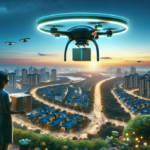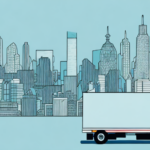The Evolution of Shipping and Delivery in the Digital Age
Over the past decade, the shipping and delivery industry has experienced a remarkable transformation driven by technological advancements. Traditional transportation methods, such as trucks and airplanes, are increasingly complemented or replaced by innovative solutions like drones and autonomous vehicles. According to a Statista report, the global drone logistics market is expected to reach over $6 billion by 2025.
The surge of e-commerce has played a pivotal role in this evolution, enabling businesses to expand their reach globally and deliver products to customers faster than ever before. Real-time tracking and monitoring systems, powered by GPS and IoT technologies, allow customers to trace their packages from dispatch to delivery, enhancing transparency and trust. This capability not only elevates the customer experience but also enables businesses to optimize delivery routes, thereby reducing transit times and operational costs.
How Shipping and Delivery Can Save You Time and Money
Efficient shipping and delivery services are crucial for both businesses and consumers, offering significant time and cost savings. Traditional transportation methods often require several days or weeks to move goods between locations. In contrast, modern shipping services can deliver products within hours or days, depending on the destination, as highlighted in the United Nations Global Shipping Statistics Report.
For businesses, this efficiency translates to reduced inventory costs and streamlined supply chain processes, ultimately enhancing profitability. Furthermore, the convenience offered by shipping and delivery services meets the growing consumer demand for online shopping, where customers expect swift and reliable deliveries. This convenience not only improves customer satisfaction but also fosters brand loyalty and repeat business.
Additionally, shipping consolidation and the use of energy-efficient transportation methods contribute to lowering the carbon footprint of both businesses and individuals. Sustainable shipping practices not only benefit the environment but also result in cost savings through reduced fuel consumption and energy usage.
The Importance of Fast and Reliable Shipping for Businesses
In the competitive landscape of e-commerce, fast and reliable shipping is a cornerstone of business success. Consumers increasingly expect prompt deliveries, and any delays can adversely affect brand reputation and customer loyalty. According to a Salesforce study, 79% of customers consider the timeliness of delivery a key factor in their purchasing decisions.
Enhancing Customer Satisfaction
Timely and consistent deliveries significantly boost customer satisfaction, encouraging repeat purchases and positive reviews. Efficient shipping also minimizes the risk of order cancellations and returns, which can be costly for businesses.
Balancing Speed and Cost
While speed is essential, businesses must also manage shipping costs to maintain profitability. Striking the right balance between fast delivery and cost-effectiveness involves selecting the right logistics partners and optimizing shipping strategies to meet both customer expectations and budget constraints.
A Comprehensive Guide to Shipping and Delivery Options
The shipping and delivery landscape offers a variety of options tailored to different needs and industries. From standard ground shipping to expedited overnight delivery, businesses can select services that align with their operational requirements and customer expectations.
Specialized Shipping Services
- Refrigerated Shipping: Essential for transporting perishable goods like food and medical supplies.
- Oversized Freight: Designed for large equipment and bulky items that exceed standard shipping dimensions.
- Express Delivery: Provides rapid delivery for urgent shipments, often within the same day or next day.
Considerations for Choosing Shipping Options
When selecting a shipping service, businesses should evaluate factors such as speed, cost, reliability, and the specific requirements of their products. Additionally, considering the environmental impact and opting for sustainable shipping options can enhance a company's reputation and appeal to eco-conscious consumers.
How to Choose the Best Shipping and Delivery Service for Your Needs
Choosing the right shipping and delivery service involves assessing several critical factors to ensure it meets your specific needs and budget.
Key Factors to Consider
- Delivery Time: Determine the required speed of delivery based on your business model and customer expectations.
- Cost: Compare shipping rates to find a balance between affordability and the level of service provided.
- Reliability: Ensure the service has a track record of timely and accurate deliveries.
- Trackability: Opt for services that offer real-time tracking and monitoring.
- Customer Service: Evaluate the provider's customer support responsiveness and effectiveness.
Specialized Shipping Needs
Consider the nature of the items you are shipping. For instance, if you frequently ship fragile or oversized items, choose a service that specializes in handling such packages with care and efficiency.
Shipping Destinations
If your business regularly ships to specific regions or countries, selecting a provider with strong coverage and expertise in those areas can enhance delivery performance and reliability.
The Advantages of Outsourcing Your Shipping and Delivery Needs
Outsourcing shipping and delivery functions can offer substantial benefits for businesses lacking the resources or expertise to manage logistics in-house.
Access to Expertise
Third-party logistics (3PL) providers bring specialized knowledge and experience, ensuring efficient handling of all aspects of the shipping and delivery process.
Cost Savings
By outsourcing, businesses can avoid the significant costs associated with maintaining their own fleet, hiring and training staff, and managing logistics operations. These savings can be redirected towards other critical areas such as product development and marketing.
Scalability and Flexibility
Outsourced services offer the flexibility to scale operations up or down based on demand, providing businesses with the agility to respond to market changes without the burden of fixed logistics costs.
How Technology is Making Shipping and Delivery More Efficient
Technological innovations are revolutionizing the shipping and delivery industry, enhancing efficiency and reducing costs.
Automation and Robotics
Automation in sorting and packaging processes minimizes manual labor, reduces errors, and accelerates processing times. According to a Forrester report, automation can increase operational efficiency by up to 30% in logistics operations.
Real-Time Tracking and Data Analytics
Integrating real-time tracking with data analytics allows logistics providers to optimize delivery routes, predict delivery times accurately, and enhance overall operational transparency.
Drones and Autonomous Vehicles
Drones are transforming last-mile delivery by accessing remote or congested areas swiftly. Autonomous vehicles promise to further reduce delivery times and operational costs by eliminating the need for human drivers.
Artificial Intelligence (AI)
AI-driven solutions predict demand trends, optimize inventory levels, and proactively identify potential delivery delays, enabling logistics providers to address issues before they escalate.
The Role of Sustainability in Modern Shipping and Delivery Practices
As environmental concerns gain prominence, sustainability has become a key focus in shipping and delivery practices.
Eco-Friendly Transportation
Adoption of electric and hybrid vehicles reduces greenhouse gas emissions and reliance on fossil fuels. According to the International Energy Agency, electric vehicles could reduce transport sector emissions by up to 70% by 2040.
Reusable and Sustainable Packaging
Implementing reusable packaging materials minimizes waste and supports a circular economy. Companies like Ecovative are leading the way in sustainable packaging solutions.
Innovative Delivery Methods
Utilizing drones for last-mile delivery and exploring autonomous ships powered by renewable energy are among the innovative practices contributing to sustainable shipping.
Common Challenges Faced by Shippers and How to Overcome Them
Despite the numerous advantages, shippers encounter challenges such as delays, damages, theft, and regulatory hurdles. Addressing these issues requires strategic planning and reliable partnerships.
Lack of Visibility and Transparency
Limited visibility in the supply chain can lead to inefficiencies and increased costs. Implementing technologies like GPS tracking and real-time monitoring systems enhances transparency and allows for timely interventions.
Delays and Shipment Loss
To mitigate delays and prevent loss, shippers should collaborate with trusted logistics providers and invest in robust tracking systems that offer real-time updates and alerts.
Risk Management Strategies
Developing comprehensive risk management strategies, including insurance and contingency planning, ensures that shippers can handle unforeseen disruptions effectively.
Innovative Solutions for Last-Mile Delivery Challenges
The last mile of delivery presents unique challenges, including high costs, congestion, and inefficiency. Innovative solutions are emerging to address these issues.
Electric Bicycles and Micro-Mobility
Electric bicycles offer a sustainable and cost-effective alternative for last-mile delivery, especially in urban areas with heavy traffic and limited parking. They enable delivery personnel to navigate narrow streets quickly and reduce fuel consumption.
Locker Systems
Automated locker systems provide secure and convenient pickup points for customers, reducing the need for home deliveries and enhancing delivery efficiency.
Drones and Autonomous Delivery Vehicles
Deploying drones and autonomous vehicles for last-mile delivery can significantly lower delivery times and operational costs, making it feasible to reach remote or difficult-to-access locations.
The Future of Shipping and Delivery: Trends to Watch Out For
The shipping and delivery industry is poised for continued evolution, influenced by technological advancements, shifting consumer behaviors, and sustainability imperatives.
Blockchain Technology
Blockchain offers secure and transparent tracking of shipments, enhancing trust and reducing fraud. Its decentralized nature ensures data integrity throughout the supply chain.
Same-Day Delivery and Subscription Services
The demand for same-day delivery continues to grow, driven by consumer expectations for instant gratification. Subscription-based delivery models are also gaining popularity, providing customers with regular and predictable delivery schedules.
Autonomous Delivery Vehicles
The development and deployment of autonomous delivery vehicles are set to revolutionize the industry by further reducing delivery times and operational costs while increasing reliability.
Integration of AI and Machine Learning
AI and machine learning will play a critical role in optimizing logistics, predicting demand, and personalizing delivery experiences to meet individual customer needs.
In summary, shipping and delivery services are essential for modern commerce, offering unparalleled convenience, efficiency, and cost savings. With ongoing technological innovations and a strong focus on sustainability, the industry is well-positioned to meet the evolving demands of businesses and consumers alike.




















